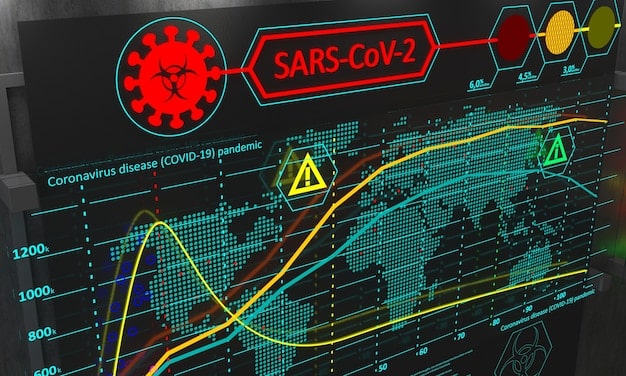EDR: Protecting Your US Business from Malware in 2025

Endpoint Detection and Response (EDR) is an essential cybersecurity solution for US businesses in 2025, providing real-time monitoring, threat detection, and response capabilities to protect against advanced malware and cyberattacks.
Is your US business prepared for the evolving landscape of cyber threats in 2025? With increasingly sophisticated malware targeting businesses of all sizes, a robust cybersecurity strategy is no longer optional – it’s a necessity. Let’s explore how Endpoint Detection and Response (EDR) can shield your organization from advanced threats.
Understanding Endpoint Detection and Response (EDR)
Endpoint Detection and Response (EDR) has become a cornerstone of modern cybersecurity, especially vital for businesses operating in the US. It’s more than just antivirus software; it’s a comprehensive approach to threat detection, incident response, and forensic analysis.
The Core Principles of EDR
At its heart, EDR revolves around continuous monitoring of endpoints – devices like laptops, desktops, servers, and mobile devices – for suspicious activities.
Key Functionalities of EDR
EDR systems provide a range of essential functions, including real-time monitoring, behavioral analysis, and automated responses. This helps in identifying and mitigating threats before they can cause significant damage.

Organizations use EDR to get deep visibility into all endpoint activity, analyze data in real time, and respond quickly to potential threats.
- Real-time Monitoring: Continuous observation of endpoint activities.
- Behavioral Analysis: Identifying deviations from normal behavior that could indicate a threat.
- Automated Response: Triggering automated actions to contain or eliminate threats.
EDR not only detects known threats but also identifies anomalies that indicate potential zero-day exploits or advanced persistent threats (APTs). This makes EDR indispensable for organizations facing sophisticated cyberattacks.
Why US Businesses Need EDR in 2025
As we approach 2025, the cybersecurity landscape is becoming more complex and perilous. US businesses face an increasing number of sophisticated and targeted cyberattacks, making EDR an essential component of their security strategies.
The Evolving Threat Landscape
In the coming years, malware will continue to evolve, becoming more evasive and difficult to detect with traditional security measures. This includes fileless malware, polymorphic malware, and AI-powered attacks.
Compliance and Regulatory Requirements
US businesses must comply with a growing number of data protection regulations, such as HIPAA, GDPR (for businesses handling EU citizen data), and CCPA. EDR helps organizations meet these requirements by providing the visibility and control needed to protect sensitive data.

Advanced threats demand advanced solutions, and EDR’s proactive approach is key to protecting businesses from modern cyber risks. Let’s examine some of the reasons for US businesses to equip themselves with advanced cybersecurity protections.
- Advanced Malware: EDR protects against evolving malware that traditional security measures often miss.
- Data Protection: EDR helps organizations safeguard sensitive data and comply with regulatory requirements.
- Business Continuity: EDR helps minimize downtime and reduce the impact of cyberattacks on business operations.
For these reasons, EDR is becoming a must-have for US businesses looking to maintain a strong security posture in the face of evolving threats.
Key Features of an Effective EDR Solution
Not all EDR solutions are created equal. To effectively protect your US business from advanced malware in 2025, it’s important to choose an EDR solution with the right features.
Real-time Threat Detection
An effective EDR solution should provide real-time threat detection capabilities, allowing you to identify and respond to threats as they occur. Machine learning algorithms identify malicious activities that conventional antivirus would miss.
Incident Response and Remediation
EDR should also provide robust incident response and remediation capabilities, allowing you to quickly contain and eliminate threats. This includes features like automated quarantining, endpoint isolation, and remote investigation tools.
An EDR must have powerful analytics capabilities and a centralized management console.
- Behavioral Analysis: The ability to analyze endpoint behavior and identify anomalies that may indicate a threat.
- Forensic Analysis: EDR should provide forensic analysis tools to investigate security incidents and identify the root cause of attacks.
- Centralized Management: A centralized management console allows security teams to monitor and manage all endpoints from a single location.
By focusing on these key features, businesses can choose an EDR solution providing the most effective protection against the evolving threat landscape.
Implementing EDR: A Step-by-Step Guide
Implementing an EDR solution can be a complex process, but by following a structured approach, US businesses can ensure a successful deployment.
Assess Your Current Security Posture
Before implementing EDR, it’s important to assess your current security posture and identify any gaps or weaknesses in your defenses. A thorough vulnerability assessment and penetration testing are vital steps.
Choose the Right EDR Solution
Select an EDR solution based on your organization’s specific needs and requirements. A good fit ensures seamless integration with your existing infrastructure.
The implementation process involves planning and configuration
- Planning: Define your security objectives and develop an implementation plan that outlines the steps required to deploy and configure EDR.
- Configuration: Configure the EDR solution to align with your security policies and operational procedures.
- Training: Train your IT staff on how to use the EDR solution and respond to security incidents.
By taking a methodical approach to implementation and working with a trusted security provider, businesses can ensure a successful EDR deployment.
Integrating EDR with Existing Security Tools
EDR is most effective when integrated with other security tools and technologies, creating a layered defense that maximizes protection against advanced malware.
SIEM Integration
Integrating EDR with a Security Information and Event Management (SIEM) system provides a comprehensive view of security events across your entire organization and improves your ability to detect and respond to threats.
Threat Intelligence Feeds
Incorporating threat intelligence feeds into your EDR solution can enhance its ability to identify and respond to emerging threats. This ensures your business is up-to-date with the latest threat intelligence.
EDR works well when integrated with other defenses
- Firewalls: Integrate EDR with your firewalls to automatically block malicious traffic and prevent attackers from gaining access to your network.
- Email Security: Integrate EDR with your email security solutions to detect and block phishing attacks and malicious attachments.
- Vulnerability Management: Integrate EDR with your vulnerability management tools to identify and remediate vulnerabilities on your endpoints.
By integrating EDR with existing defenses, companies can create a cohesive security ecosystem.
The Future of EDR: Trends to Watch in 2025
As the cybersecurity landscape continues to evolve, so too will EDR solutions. Several key trends are expected to shape the future of EDR in 2025.
AI and Machine Learning
AI and machine learning will play an increasingly important role in EDR, enabling solutions to automatically detect and respond to threats with greater speed and accuracy. These technologies will analyze vast amounts of data to identify patterns and anomalies that indicate malicious activity.
XDR (Extended Detection and Response)
XDR takes EDR to the next level by extending threat detection and response capabilities across multiple security layers, including endpoints, networks, and cloud environments. This provides a more holistic view of the threat landscape and enables faster, more effective incident response.
EDR is expected to incorporate cloud technologies.
- Cloud-Based EDR: Cloud-based EDR solutions offer several advantages, including scalability, flexibility, and reduced operational overhead.
- Integration with Cloud Security Tools: EDR will increasingly integrate with cloud security tools to provide comprehensive protection for cloud workloads and data.
By keeping an eye on these trends and embracing new technologies, US businesses can stay ahead of the curve.
| Key Point | Brief Description |
|---|---|
| 🛡️ Real-time Threat Detection | Identifies and responds to threats instantly using advanced algorithms. |
| 📊 Behavioral Analysis | Detects anomalies in endpoint behavior to uncover potential threats. |
| 🚨 Incident Response | Provides robust tools for containing and eliminating security incidents. |
| 🤖 AI Integration | Uses artificial intelligence to improve threat detection accuracy and speed. |
Frequently Asked Questions (FAQ)
▼
The primary benefit of EDR is enhanced threat detection and response capabilities, which allow businesses to quickly identify and mitigate advanced malware and cyberattacks.
▼
EDR differs from traditional antivirus software by providing continuous monitoring, behavioral analysis, and automated response capabilities that go beyond signature-based detection.
▼
Businesses of all sizes benefit from EDR solutions, especially those that handle sensitive data or operate in highly regulated industries, such as healthcare and finance.
▼
Yes, EDR helps organizations meet compliance requirements by providing visibility and control over endpoint activity, which aids in protecting sensitive data and adhering to regulatory standards.
▼
Key features to look for in an EDR solution include real-time threat detection, incident response, behavioral analysis, forensic analysis, and centralized management.
Conclusion
Protecting your US business from advanced malware in 2025 requires a proactive and comprehensive approach to cybersecurity. Endpoint Detection and Response (EDR) offers the tools and capabilities needed to detect, respond to, and mitigate sophisticated threats, ensuring the security and continuity of your business operations. By understanding the principles of EDR, implementing the right solution, and staying informed about emerging trends, you can safeguard your organization against the evolving cyber threat landscape.





